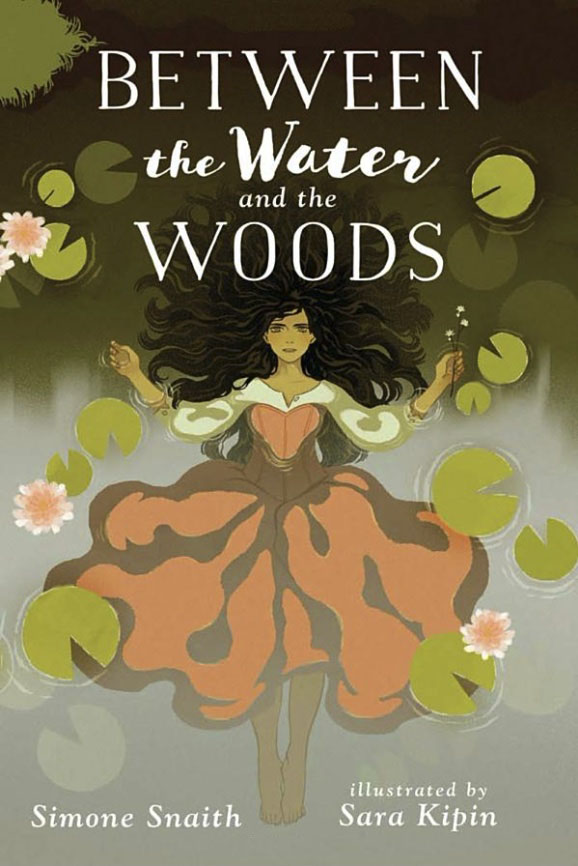
Genre: YA, Fantasy, Steampunk
Reviewer: Lee
Get It On Amazon | Publisher | B&N
About The Book
Emeline’s quiet village has three important rules:
Don’t look at the shadows.
Don’t cross the river.
And don’t enter the forest.
An illustrated fantasy filled with beauty and power, Between the Water and the Woods sweeps you into a world where forests are hungry; knights fight with whips; the king is dying; and a peasant girl’s magic will decide the future of the realm . . .
When Emeline’s little brother breaks all three of their village’s rules, she is forced to use her family’s forbidden magic to rescue him from the dark things he awakens, the Ithin. Now that the Ithin are afoot in the land, she must, by law, travel to the royal court and warn the king. But the only way she and her family can make the journey to the capital is with the protection of a sour magister and a handsome, whip-wielding Lash Knight. Will Emeline survive in a city where conspiracies swirl like smoke and her magic is all but outlawed?
Seven full-page black-and-white illustrations accompany Between the Water and the Woods, a lush, fairy-tale-style fantasy perfect for readers of Karen Cushman and Shannon Hale.
The Review
Between the Water and the Woods (BWW), by Simone Snaith starts with a warning or a set of rules much like in The Village, not to cross the water, and definitely not to go into the woods. Yes, we have heard this kind of warning before, but it still viscerally grabbed me, and Snaith quickly goes in her own direction with it.
In the first pages of the novel, Emeline—a girl on the verge of womanhood—breaks these rules by crossing the water and approaching the woods. She does this to save her younger, much less mature, brother. Naturally, this awakes the ire of the creatures of the woods, propelling Emeline and her family on a journey from their subsistence level fishing village to the wealthy, technologic capitol. There they find themselves embroiled in a political battle between the mystical Theurgist and rational Sapient cabals.
This novel plays squarely to the YA audience. This is no criticism of the prose, which is competent and economic, but points to the focus of the story, which is on young people and their concerns. Emeline’s brother and his friend want to be knights, and view most of what is happening in a childlike way. Of a more mature mindset of Emeline, who is undergoing a transformation into womanhood. Emeline is unsophisticated, unworldly—but not unintelligent—which gives her great potential for change. She is uncomfortable with fashion, with how she is perceived by others, including potential lovers, and her own burgeoning nature-elemental magic. The awakening of the creatures in the woods and the trip to the capitol force her to face her adulthood, power, and place in the world.
I noted that a reviewer elsewhere took aim at The Village-like warning about the woods, given so dramatically at the story’s opening. I loved The Village, and BWW’s start felt more like homage, if anything. Many readers will recognize that the idea of a dangerous wilderness is not an original construct of Shyamalan, but dates back to the Greeks. Oedipus Rex, by Sophocles, now written twenty-five hundred years ago, makes noted use of the concept. Oedipus leaves the safety of the polis, or city, for the wilderness where only gods and monsters live. He becomes both a god (in his own mind) and a monster (definitively), killing his father and marrying his mother. Criticism of art is an art in itself, but it is best for reviewers to understand art history when laying down judgement. Snaith is not ripping off Shyamalan any more than Shyamalan ripped off Sophocles. The question that needs to be asked is: does Snaith do anything interesting with the trope?
The answer, I think, is yes. In The Village, Shyamalan took aim at violence and perhaps, war. Snaith’s BWW is concerned with dualities and dichotomies. As many readers know, a duality describes two contrasting aspects of a single thing, while a dichotomy describes two opposing and separate things. We may well ask if the water and the woods represent a dichotomy, as everyone seems to believe, or a duality? Is continued conflict unavoidable? Are nature and science to be pitted against one another as the Theurgists and Sapients seem to wish, or will someone find a way of bringing these contrasting perspectives together? Most importantly, how will Emeline manage her dual nature as child-woman, and person of reason and woman of magic?
BWW ends on a happy enough note, although too much of the explanation for the conflict was through telling rather than showing. This too straight forward approach somewhat limits the thematic power of the story, which is unfortunate because Snaith has something important to say. Some of the technical elements of the steampunk aspect of BWW are not sufficiently developed, which may threaten suspension of disbelief in adults. But BWW is a YA book, and these criticisms may only weakly apply to her intended audience. The serious thematic questions that Snaith raises deserve additional development and I hope that she writes another book in this world.
Takeaway: A firmly Young Adult Fantasy story that will interest readers concerned with the dualities of childhood and adulthood, and science and nature. Snaith shows that all human beings need to process their transition from younger selves to the adults they become, and the proper goal of science is to understand—not deny—nature.
The Reviewer
Lee has a background in physics and applied science, but has always enjoyed reading fiction. His first serious forays in writing came from dungeon mastering and high school drama club, although for nearly three decades as a geophysicist, he wrote only non-fiction. At the age of 25, Lee spent a prolonged period of time on the edge of death, had the last rights read to him, and enjoyed several near death experiences. Not even all the morphine could make him forget those. Lee enjoys rock climbing, cycling, hiking, swimming and writing. He is an Ironman Triathlete.

